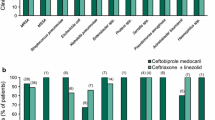Abstract
Cefprozil is a new oral cephalosporin with an enhanced in vitro spectrum of activity that includes group A β-hemolytic streptococci (GABHS). Four multicenter randomized clinical trials were conducted to compare the clinical efficacy and safety of cefprozil administered once or twice a day for the treatment of mild to moderate GABHS tonsillitis and pharyngitis. A total of 1597 patients were enrolled in the trials. Patient demographics and severity of infection were similar for all treatment groups. In Study 1, cefprozil administered at 20 mg/kg once daily was clinically, in 68 of 76 patients (89 %) and bacteriologically, in 66 of 74 patients (89 %) superior to penicillin — 51 of 69 (74 %) and 46 of 69 (67 %) — administered three times a day in patients of two to 12 years of age. In Study 2, the patients enrolled were 13 years of age and older, and cefprozil administered at 20 mg/kg once a day had similar clinical (93 % vs. 90 %) and bacteriological (95 % vs. 94 %) response rates as cefaclor administered three times a day. Study 3 demonstrated that cefprozil administered twice daily was similar to penicillin given three times a day, the clinical satisfactory response being 164 of 175 (94 %) for cefprozil and 146 of 165 (88 %) for penicillin. In Study 4, identical clinical and bacteriologic responses (95 %) were observed for cefprozil administered once a day and erythromycin ethylsuccinate administered four times a day in children over two years of age. There were no significant differences in the incidence or severity of drug-related adverse events, which, when reported, were mild and transient. These studies suggest that cefprozil can provide therapy for the treatment of mild to moderate tonsillopharyngitis in a once-daily or twice-daily dosage regimen, and is a reasonable alternative to penicillin, cefaclor, and erythromycin.
Similar content being viewed by others
References
Gerber MA, Markowitz M: Management of streptococcal pharyngitis reconsidered. Pediatric Infectious Diseases 1985, 4: 518–526.
Walsh BT, bookheim WW, Johnson RC, et al.: Recognition of streptococcal pharyngitis in adults. Archives of Internal Medicine 1975, 135: 783–792.
Dajani AS, Bisno AL, Chunk KY, Chung KJ, Durack DT, Gerber MA, Kaplan EL: Prevention of rheumatic fever. Circulation 1988, 78: 1082–1086.
Bisno AL: Group A streptococcal infections and acute rheumatic fever. New England Journal of Medicine 1991, 325: 783–792.
Dajani AS: Prevention of rheumatic fever. Infections in Medicine 1989, 6: 190–192.
Klein JO: Reemergence of virulent Group A streptococcal infections. Pediatric Infectious Diseases 1991, 10, Supplement: S3–6.
Catanzaro FJ, Rammelkamp CH, Chamovitz R: Prevention of rheumatic fever by treatment of streptococcal infections II: factors responsible for failures. New England Journal of Medicine 1958, 259: 51–57.
Gastanaduy AS, Kaplan EL, Huwe BB, McKay C: Failure of penicillin to eradicate group A streptococci during an outbreak of pharyngitis. Lancet 1980, iii: 498–502.
Kaplan EL, Gastanaduy AS, Huwe BB: The role of the carrier in treatment failures after antibiotic therapy for group A streptococci in the upper respiratory tract. Journal of Clinical Laboratory Medicine 1981, 98: 326–335.
Brook I: Role of beta-lactamase producing bacteria in the failure of penicillin to eradicate group A streptococci. Pediatric Infectious Diseases 1985, 4: 491–495.
Pichichero ME: Controversies in the treatment of streptococcal pharyngitis. American Family Physician 1990, 42:1567–1576.
Pichichero ME, Margolis PA: A comparison of cephalosporins and penicillins in the treatment of Group A beta-hemolytic streptococcal pharyngitis: a meta-analysis support the concept of copathogenicity. Pediatric Infectious Diseases 1991, 10: 275–281.
Barbhaiya RH, Shukla UA, Gleason CR, Shyu WC, Wilber RB, Martin RR, Pittman K: Phase I study of multiple dose cefprozil and comparison with cefaclor. Antimicrobial Agents and Chemotherapy 1990, 34:1198–1203.
Barbaihya RH, Shukla UA, Gleason CR, Shyu CW, Wilber RB: Comparison of cefprozil and cefaclor pharmacokinetics and tissue penetration. Antimicrobial Agents and Chemotherapy 1990, 34: 1204–1209.
Kessler RD, Fung-Tomc JC: In vitro activity of cefprozil compared with other cephalosporins. Infections in Medicine 1992, 9, Supplement C:10–18.
Shyu WC, Reilly J, Campbell DA, Wilber RB, Barbhaiya RH: Penetration of cefprozil into tonsillar and adenoidal tissue. Antimicrobial Agents and Chemotherapy 1993, 37: 1180–1183.
Leitner F, Pursiano TA, Buck RE, Tsai YH, Chisholm DR, Misiek M, Desiderio JV, Kessler RE: BMY 28100, a new oral cephalosporin. Antimicrobial Agents and Chemotherapy 1987, 31: 238–243.
Author information
Authors and Affiliations
Rights and permissions
About this article
Cite this article
McCarty, J.M. Comparative efficacy and safety of cefprozil versus penicillin, cefaclor and erythromycin in the treatment of streptococcal pharyngitis and tonsillitis. Eur. J. Clin. Microbiol. Infect. Dis. 13, 846–850 (1994). https://doi.org/10.1007/BF02111351
Issue Date:
DOI: https://doi.org/10.1007/BF02111351




